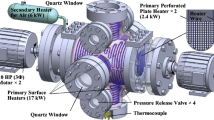Abstract
Effects of the recession of the central air jet on the visible flame height, necking zone, and luminosity of a turbulent compressed natural gas-air inverse diffusion flame in a coaxial burner are investigated in this experimental study. The inner circular tube of the coaxial burner is recessed by 0.25d a , 0.5d a , and 1.0d a , where d a is the central tube inner diameter. From the visual observation, the flame height and the necking zone height are observed to decrease exponentially with the air jet Reynolds number with no recession of the central air jet. However, only a marginal reduction in the visible flame height is observed with an increase in the recession height of the air jet as compared to the necking zone height. Interestingly, the necking zone at the flame base disappears beyond the critical recession height of the central jet. Moreover, the recession is found to be effective in eradicating the fuel rich zone and soot ring at the flame base of turbulent compressed natural gas inverse diffusion flame at lower air jet Reynolds numbers.
Similar content being viewed by others
References
A. Sobiesiak and J. C. Wenzell, “Characteristics and Structure of Inverse Flame of Natural Gas,” Proc. Combust. Inst. 30, 743–749 (2005).
L. K. Sze, C. S. Cheung, and C. W. Leung, “Appearance, Temperature and NOx Emission of Two Inverse Diffusion Flames with Different Port Design,” Combust. Flame 144, 237–248 (2006).
S. Mahesh and D. P. Mishra, “Stability and Emission Characteristics of Turbulent LPG IDF in a Backstep Burner,” Fuel 87, 2614–2619 (2008).
S. Mahesh and D. P. Mishra, “Flame Structure of LPG-Air Inverse Diffusion Flame in a Backstep Burner,” Fuel 89(8), 2145–2148 (2010).
S. Mahesh and D. P. Mishra, “Study of the Turbulent Inverse Diffusion Flame in Recessed Backstep and Coaxial Burners,” Fiz. Goreniya Vzryva 47(3), 30–36 (2011) [Combust., Expl., Shock Waves 47 (3), 274–279 (2011)].
T. W. Lee, M. Fenton, and R. Shankland, “Effects of Variable Partial Premixing on Turbulent Jet Flame Structure,” Combust. Flame 109, 237–248 (1997).
Author information
Authors and Affiliations
Corresponding author
Additional information
Original Russian Text © S. Mahesh, D.P. Mishra.
__________
Translated from Fizika Goreniya i Vzryva, Vol. 48, No. 6, pp. 28–34, November–December, 2012.
Rights and permissions
About this article
Cite this article
Mahesh, S., Mishra, D.P. Effects of recessed air jet on turbulent compressed natural gas inverse diffusion flame shape and luminosity. Combust Explos Shock Waves 48, 683–688 (2012). https://doi.org/10.1134/S0010508212060032
Received:
Published:
Issue Date:
DOI: https://doi.org/10.1134/S0010508212060032




